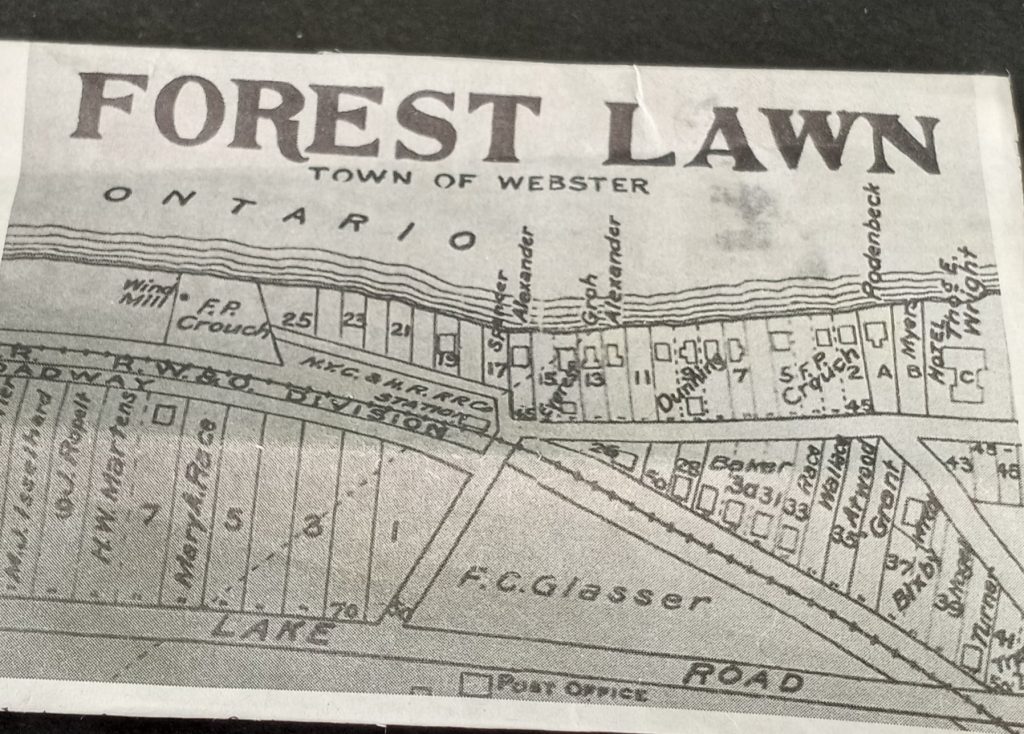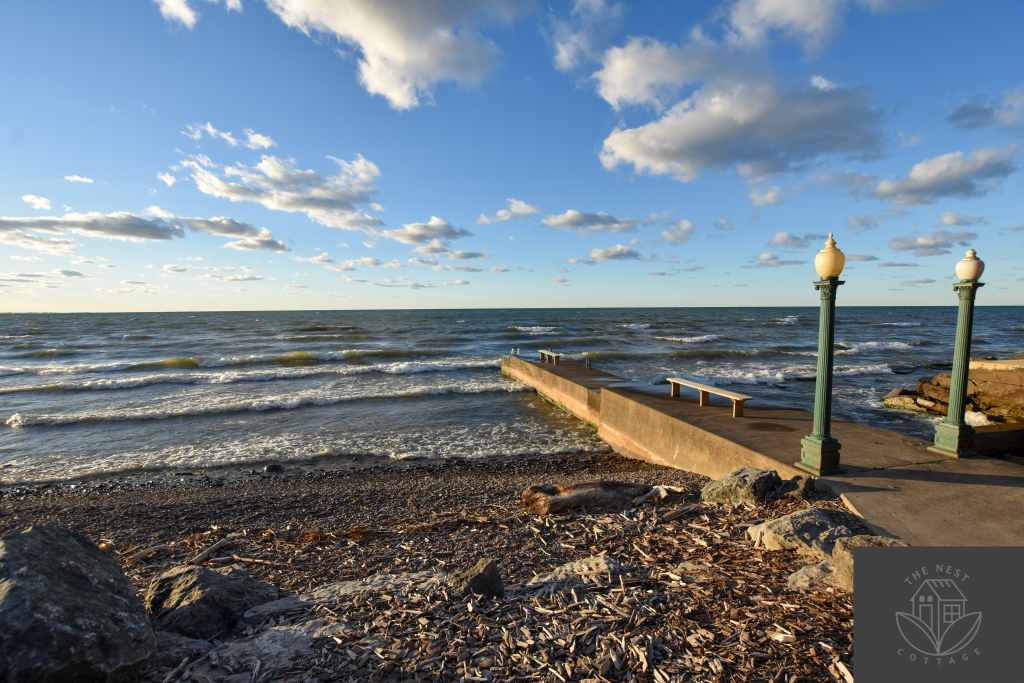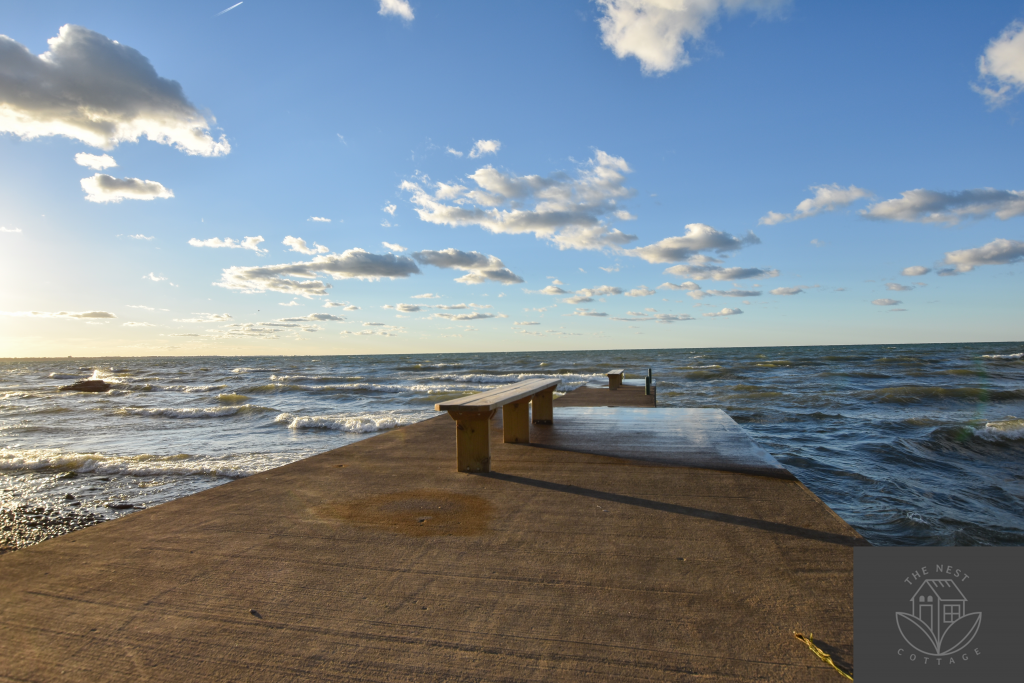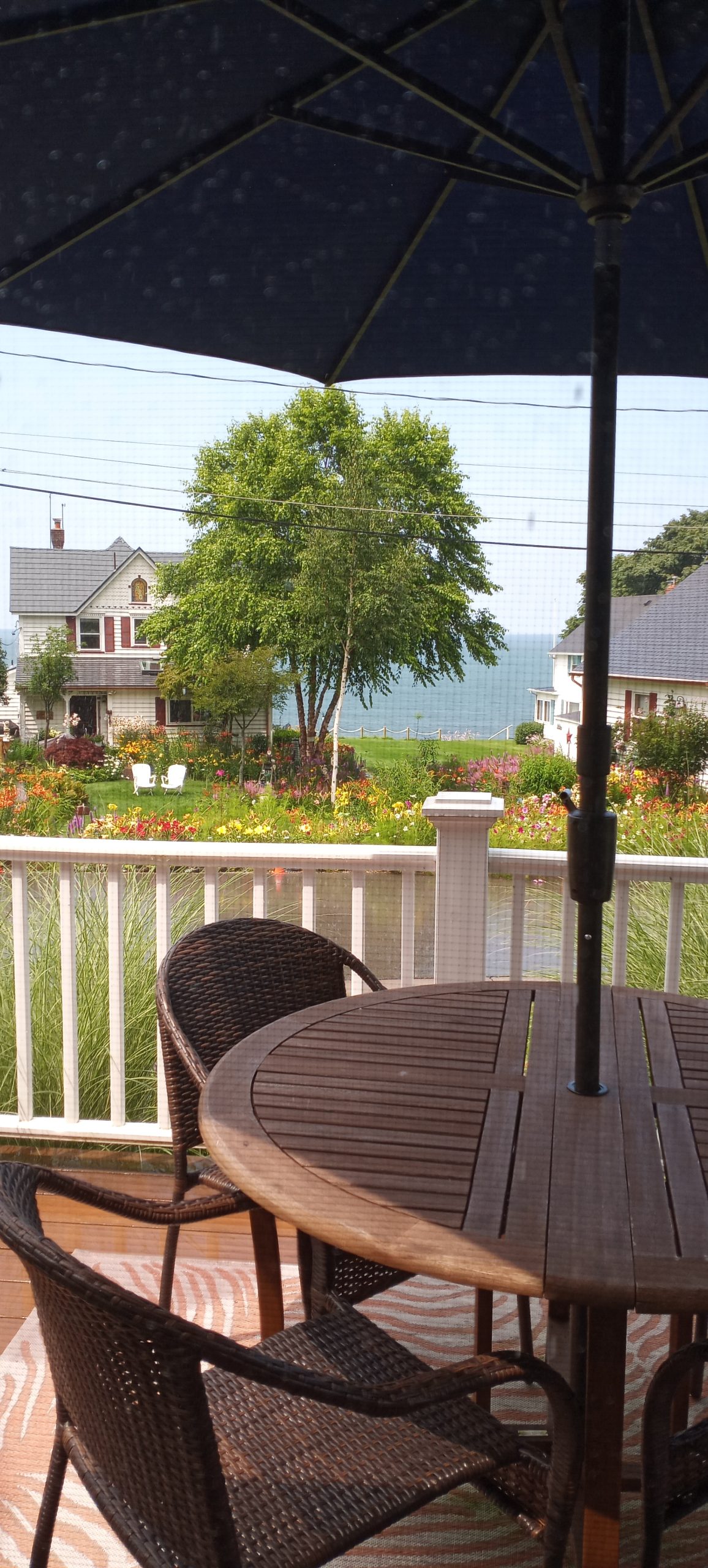
The Forest Lawn Community:
Situated on the beautiful shores of Lake Ontario, in the town of Webster, a suburb of Rochester, in the state of New York is the precious little community of Forest Lawn. In this community, you will find kind, caring and generous neighbors. There is a sense of pride and a commitment to the history of this community.
The Forest Lawn Community Association works hard to honor the values and the traditions that have been celebrated here since the beginning. The Forest Lawn Association works to protect property values, promote social interests and celebrate neighborliness.
August 2023 celebrated the 135th Anniversary of the Forest Lawn Association.
Lively neighborhood traditions thrive today. The Calendar is jam packed with events such as:
Annual Field Day celebrations, Steak Roasts, Halloween Parties, and our Annual Bay Bridge ‘In and Out’ Dinners; as well as weekly Summer Sailing Parties and Beach Bonfires.
Forest Lawn Historic Map:

The Timeline of
Webster’s
Forest Lawn Community:
1818
The Stagecoach:
The stagecoach began service from Oswego to Rochester.
Webster Stagecoach Stops:
1-Robb’s Tavern: at the corner of Phillips and Ridge Roads
2-Spear’s Tavern: (former Stagecoach Inn) built 1812
3-Buttermilk Tavern: SW Corner Five Mile Line and Ridge, “Benedict Corners”
4-“Bee-Hive”: Ridge Road the home of Ebenezer Cook, Webster’s first blacksmith
1819-1860
Missisaugas Native Americans:
A band of Missisaugas Native Americans of the Ojibwe Tribe had a village near Shipbuilder’s Creek.
It was dubbed Shipbuilder’s Creek as boats were built along its course.
Samuel Street:
The first owner of the property in this area is recorded as Samuel Street of Niagara.
Author Esther A. Dunn states in her book Webster Through the Years:
“He paid one shilling, five pence per acre for the land being described as being east of the River Urundegut.“
1859
Samuel Pierce:
Author Esther A. Dunn states in her book Webster Through the Years:
“Mr. Samuel Pierce purchased 200 acres which extended from Oklahoma Beach and Irondequoit Bay through the present “Lawn”.”
At the time, people whose ancestors had built boats along the creek where living on the land.
Mr. Pierce appealed to the state authorities to dislodge the squatters.
1876
The Railroad:
The Rome, Watertown and Ogdensburg Railroad was in operation.
1888
The Stagecoach:
Operation of a passenger and freight stagecoach from Webster to Rochester began.
Horace Pierce:
Samuel and Electa Burnett Pierce deeded the land to their son, Horace Pierce.
The land at the mouth of Shipbuilders Creek, was level to the lake, making it a desirable location for a cottage development.
The Forest Lawn Community:
The Forest Lawn Community was developed in 1888
by Horace Pierce and his friend and fellow attorney, George D. Forsyth.
They saw potential commercial opportunities in developing the land due to its proximity to the lake and a then proposed railway line.
They had the plot of land surveyed and organized into lots and roadways.
They began construction of the Forest Lawn Community.
The Clubhouse:
The lake front community of Forest Lawn boasted a Clubhouse.
The clubhouse was a large-framed building 3-stories high.
On the second, third and part of the first floor were sleeping quarters.
On the first floor were the kitchen, dining room, assembly rooms, and a big porch.
It was one of the largest structures along the lakeshore.
The Members and Cottagers:
There was reserved for every owner of the tract a right-a-way on each side of the creek.
A pier was constructed at the mouth of the creek extending into the lake.
The structure was surrounded with summer cottages, a ball field, pier and creek.
Members and cottagers could come for meals, weekly dances, and parties.
1889
The Railroad Wreck:
One of the worst wrecks on the Rome, Watertown, and Ogdensburg Railroad happened at Forest Lawn.
Esther A. Dunn wrote of the incident in her book Webster Through the Years:
“Shortly before 6:00am on August 10, 1889, the commuters were boarding the “stub line” for Rochester
when the passenger train westbound from Thousand Islands crashed into it.
The flyer was late and was trying to make up for lost time.
Somewhere the signals were wrong.
When the trains met in a shattering crash, the commuter train was telescoped and flung against the station.
The steam locomotive of the other train ground off into the sand and exploded. Dead and injured lay scattered under smoke and steam.“
1890‘s
The Summer Hotel:
The Forest Lawn Club was not a financial success.
Mr. Horace Pierce decided to use the Clubhouse as a Summer Hotel.
The Bicycle Period:
The first bicycle in Webster was owned by John Campbell and Clarence McKay.
It was made by Mr. Henry Bowman, a blacksmith in Roseland.
Transportation to the Community, before the advent of the automobile, was by horse-drawn vehicles, bicycles or the train.
The Pathway:
Mr. George Forsyth engineered a path from Oklahoma Beach east along the northside of the railroad embankment to Forest Lawn.
A narrow boardwalk, with a railing, midway between the railroad track and the lake shore.
This path served the bicycle riders and pedestrians for many years.
1899
Thomas Wright:
Mr. Pierce was succeeded by Mr. Thomas Wright.
1900
The Fire:
The original clubhouse burned down.
The Re-Build:
Mr. Wright then built a large gambrel-roof building which could accommodate 300 guests.
The Trolley:
Rochester & Sodus Bay Trolley made its first run through the town of Webster.
Wealthy judges and lawyers from Corn Hill soon discovered the area.
They commuted to the city of Rochester by trolley for business, while their families enjoyed summers at the lake.
1907
The Sale:
Mr. Wright sold the property at Forest Lawn.
1908
The Fire:
A raging nighttime fire destroyed the structure, it was never rebuilt.
1914
The Railroad:
The Rome, Watertown and Ogdensburg Railroad became a part of the New York Central system.
1910’s-1920’s
Year-round Residences:
Over time the homeowners of Forest Lawn winterized the 60 charming cottages, installed gardens, and paved the private streets.
They continued to honor the traditions of the community.
1915-1917
The Bus:
George Henner’s Lake Shore Bus operated on a regular schedule during the summer months.
His route was from Webster village to Nine Mile Point, along Lake Road west to Sea Breeze,
Culver Road to the railroad bridge on East Main Street, and return.
It made connections with the Sodus Bay Trolley and the Sea Breeze Trolley lines.
1924
The Streetlights:
RGE president Alexander Beebee moved the discarded downtown streetlights in front of the Sibley Building
to the streets of his beloved Forest Lawn neighborhood.
1929
The RTS:
The last run of the Sodus Bay Trolley was followed by the first bus of the Rochester Transit System.
1937
The Park:
Webster County Park came into being.
1964
The End of an Era:
The Webster depot closed its doors to business in 1964.
1968
The Hojack Line:
The Webster depot was sold to the Lawyers Cooperative Publishing Company of Rochester and Webster.
The railroad line a part of the Penn Central Railroad System has been commonly referred to as the Hojack Line.
“Ho-Jack”
as the story goes….
by Esther A. Dunn in Webster Through the Years:
In the early days of the railroad,
a farmer in his buckboard drawn by a mule was caught on a crossing at train time
The train was fast approaching, and the farmer called out, “Ho-Jack, Ho-Jack”
Amused by the incident, the trainmen began calling their line the “Ho-Jack”.
2013
Memorial Brick Walk:
Forest Lawn resident, Ryan Paprocki coordinates construction of FLA Memorial Brick Walk, embedding signature bricks from neighbors past and present.
2014
Shipbuilders Creek Road Sign:
George Winter builds and installs new, highly polished wood road sign for
Shipbuilders Creek Road.
2017
Danny McElroy rescues memory bricks from creek’s overflowing wrath.
2018
Reconstruction of Memorial Brick Walk.
Present Day
The Hojack Trail:
Today the Hojack Line is a mix-use trail stretches 3.5 miles across the town of Webster.
It is maintained by the Friends of Webster.
It is a popular walking and biking trail.
The Forest Lawn Community:
As stated on the Forest Lawn Community website:
“Today, we also have a charming walk-bridge over the creek,
enhancing lazy feet-dangling afternoons;
the pier still is a summer mainstay for swimming and boating.
All remain cherished assets of this family-friendly neighborhood.
The ball field continues to serve as a playground for kids and adults enjoying baseball, soccer, lacrosse, volleyball, and hockey games. Lively neighborhood traditions thrive today with annual Field Day celebrations, Steak Roasts, Halloween Parties, and our annual Bay Bridge In and Out dinner parties as well as weekly summer sailing parties and beach bonfires.
Yes, Forest Lawn is a fun place to live and play!
The Forest Lawn Association works to safeguard the Forest Lawn traditions and assets,
protect property values,
promote social interests and celebrate neighborliness.
In summary,
Forest Lawn is a unique and caring community of residents that routinely live out their lives
rooted in the values they are dedicated to including:
Tradition, Beauty, Celebration, Stewardship and Neighborliness.“
LINKS TO HISTORIC PHOTOS:
LAKESHORE
Source: The Forest Lawn Community
EVENTS
Source: The Forest Lawn Community
NEIGHBORS
Source: The Forest Lawn Community

Photo credit: Forest Lawn Community Website
PHOTOS:
Forest Lawn Beach

Forest Lawn Pier

Our Experience:
Our experience as owners of The Nest Cottage
nestled in The Forest Lawn Community:
Although our time spent here is brief, we feel honored to be a part of this stellar community.
There is such a wonderful old-timey feel that this community has.
Children laughing and playing, neighbors taking walks and plenty of furry friends.
We love walking Madi around and waving hello to our friends and neighbors.
It brings great joy to our day when someone passes by the cottage and stops to chat.
People come from afar to see my neighbor’s beautiful garden.
We have the joy of looking out to Parker and Zed’s amazing display:
a collection of lilies, perennials and annuals.
In front of their house, the street is lined with sneakers planted with sedum and colorful cosmos.
Never is a Summer’s Day that Parker, or one of his amazing crew is not out toiling away in the soil.
It is truly a beautiful garden to behold.

A small glimpse of the view of the garden from our deck.
Wishing you joy and happiness.
in JOY-Trisha
The Webster Museum:
History buffs who stay at The Nest Cottage
will definitely want to explore more about
the Forest Lawn Neighborhood and the town of Webster.
The best place to go is:
The Webster Museum
located at: 18 Lapham Park Webster, NY 14580
hours: Saturday, Tuesday and Thursday 2:00-4:30pm.
No Admission Charge.
Call (585)265-3308 if you would like to arrange a group tour.
For those of you who are visiting remotely the
Webster Museum website
has a lot of information on the area.
Books:
You might also want to read more about the history of Webster, NY.
We recommend these two books:
Webster Through the Years
by Esther Dunn $19.75
Webster Images of America
by Lynn M. Barton, Joan E. Sassone, and Mary Hasek Grenier $23.75
These books are available at the:
Webster Museum Store and Amazon.
Resale books are also available:
Yesterday’s Muse Books
You will find copies available at:
The Nest Cottage
for your enjoyment while staying with us.
Source List:
The Forest Lawn Community website
The Webster Museum
Images of America by Lynn M. Barton, Joan E. Sassone, Mary Hasek Grenier
Webster Through the Years by Esther A. Dunn
